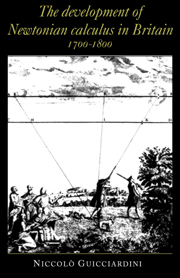Book contents
- Frontmatter
- Contents
- Introduction
- OVERTURE: NEWTON'S PUBLISHED WORK ON THE CALCULUS OF FLUXIONS
- PART I THE EARLY PERIOD
- PART II THE MIDDLE PERIOD
- PART III THE REFORM
- CONCLUSION
- APPENDIX A TABLES OF CONTENTS OF FLUXIONARY TEXTBOOKS
- APPENDIX B PRICE LIST OF MATHEMATICAL BOOKS PRINTED FOR JOHN NOURSE
- APPENDIX C CHAIRS IN THE UNIVERSITIES
- APPENDIX D MILITARY ACADEMIES
- APPENDIX E SUBJECT INDEX OF PRIMARY LITERATURE
- APPENDIX F MANUSCRIPT SOURCES
- Notes
- Bibliography
- Index
APPENDIX A - TABLES OF CONTENTS OF FLUXIONARY TEXTBOOKS
Published online by Cambridge University Press: 14 September 2009
- Frontmatter
- Contents
- Introduction
- OVERTURE: NEWTON'S PUBLISHED WORK ON THE CALCULUS OF FLUXIONS
- PART I THE EARLY PERIOD
- PART II THE MIDDLE PERIOD
- PART III THE REFORM
- CONCLUSION
- APPENDIX A TABLES OF CONTENTS OF FLUXIONARY TEXTBOOKS
- APPENDIX B PRICE LIST OF MATHEMATICAL BOOKS PRINTED FOR JOHN NOURSE
- APPENDIX C CHAIRS IN THE UNIVERSITIES
- APPENDIX D MILITARY ACADEMIES
- APPENDIX E SUBJECT INDEX OF PRIMARY LITERATURE
- APPENDIX F MANUSCRIPT SOURCES
- Notes
- Bibliography
- Index
Summary
Table of contents of William Emerson's The Doctrine of Fluxions (1743) (2nd edn., 1757)
Preface
The Doctrine of Fluxions
Postulatum
Definitions
Notation
Axioms
Section I The Fundamental Principles and Operations of Fluxions
Prop.I. The fluxion of any fluent or generated quantity is equal to the sum of the fluxions of all the roots or sides, each multiply'd continually by the index of its power, and by the given fluent when divided by the said root or side
Prop.II If two fluents or variable quantities be equal to each other, or in a given ratio; their fluxions will be equal, or in the same given ratio. And if two flowing quantities be equal or in a given ratio, their contemporary fluents will be equal, or in the same given ratio
Prop.III To find the fluxions of quantities Prop. IV–VIII several theorems for finding the fluents of quantities from other given fluents
Prop.IX To transform fluxional quantities into others equal to them
Prop.X To find the fluents of quantities by infinite series
Prop.XI To find fluents by the table
Prop.XII To correct the fluent of a given fluxions
Prop.XIII To investigate a problem by the method of fluxion
Section II The investigation and solution of some of the most general and useful problems in the mathematics
Prob.I To find the maxima and minima of quantities
Prob.II To find the logarithms of numbers
- Type
- Chapter
- Information
- The Development of Newtonian Calculus in Britain, 1700–1800 , pp. 143 - 147Publisher: Cambridge University PressPrint publication year: 1989



